Basic AI Chatbot Pricing: A simple chatbot that can answer questions about a product or service might cost around $10,000 to develop.
Read More
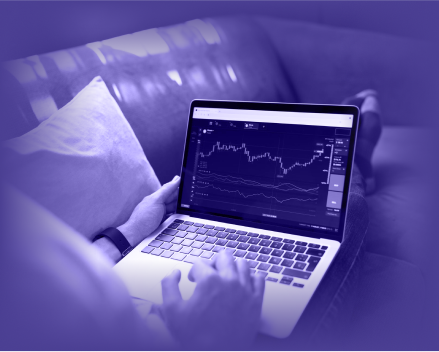
The financial markets have always rewarded speed, precision, and smart decision-making. But in today’s fast-moving digital era, human traders alone can’t keep up with the endless flow of market data, news, and price swings. That’s where automation steps in — and it’s changing the trading game forever.
At the heart of this shift are trading bots — digital assistants that can scan markets, place trades, and manage risks faster than any human could. But here’s the exciting part: these bots are no longer just rule-based machines that follow static instructions. Thanks to AI agents, they’re becoming intelligent, adaptive, and even conversational.
Imagine this: a trader is watching Bitcoin dip slightly while scrolling through news. By the time she analyzes the headlines and checks her indicators, the price has already bounced back — the opportunity is gone. Meanwhile, her AI-powered trading bot, guided by an AI agent, had already processed the news sentiment, detected the dip as a buying signal, and executed the trade in seconds. The difference? Lost chance for the human, profitable entry for the bot.
In this guide, we’ll explore how traders can develop trading bot using AI agent to enhance their strategies, improve decision-making, and gain an edge in the markets. Whether you’re a retail trader curious about automation or a professional looking for advanced AI-powered tools, this journey into the future of trading will show you what’s possible.
At its core, an AI agent is a system that can observe its environment, process information, and make decisions on its own. In the context of trading, AI agents act like intelligent co-pilots — they don’t just follow fixed instructions, they learn, adapt, and respond to market changes in real time.
This is very different from traditional trading algorithms. Old-school bots work on static, rule-based logic: “If the price falls below X, then buy. If it rises above Y, then sell.” While effective in stable conditions, these rigid bots struggle when markets get volatile, when unexpected news breaks, or when sentiment suddenly shifts.
By contrast, AI agents in building trading bots bring a layer of intelligence. They can analyze vast streams of data — price action, technical indicators, economic reports, even social media chatter — and adjust strategies dynamically. The role of AI agents isn’t just about executing trades at lightning speed; it’s about making smarter, context-aware decisions.
For traders looking to develop trading bot using AI agent, the advantages are clear:
In short, trading bot development with AI agents gives traders more than automation — it gives them a competitive edge powered by intelligence, not just speed.
Traditional trading bots have been around for years, and while they’ve helped automate repetitive tasks, they operate on rigid, pre-programmed rules. For example, a rule-based bot might be told: “Buy when the moving average crosses upward and sell when it crosses downward.” This works fine in stable conditions, but markets are rarely stable for long.
When market volatility spikes — say, after unexpected inflation data or breaking geopolitical news — these bots often fail. They can’t adjust their logic to new situations, leading to late entries, false signals, or missed opportunities.
AI-powered bots, however, bring adaptability. With the help of AI agents, these bots can analyze multiple data streams in real-time — technical indicators, order book depth, sentiment from social media, and even macroeconomic headlines. Instead of following a single rule, they can weigh probabilities, adjust positions, and learn from past outcomes. This makes them not just faster, but smarter.
It’s no surprise, then, that more traders are moving towards trading bot development with AI agents for accuracy and flexibility. By embracing adaptive strategies, AI-driven bots allow traders to stay ahead in markets that shift by the second, where milliseconds and smart decisions mean the difference between profit and loss.
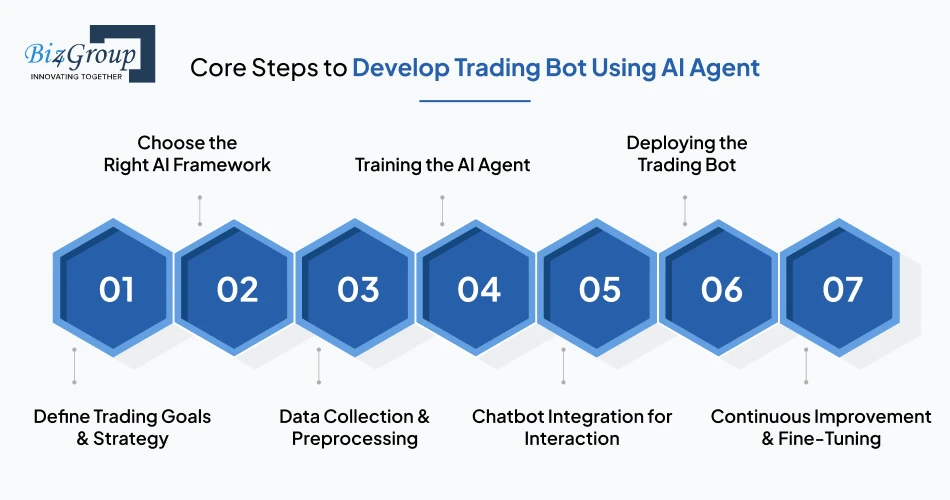
Creating an AI-powered trading bot is a journey that blends strategy, data, and technology. For traders and businesses aiming to develop trading bot using AI agent, the process can be broken into structured steps. Each step requires careful planning, and in many cases, working with an experienced AI agent development company or Python development company can make the journey faster and more efficient.
Every successful bot starts with clarity. Traders need to decide:
Defining a strategy helps the AI agent understand the objectives. Without clear goals, even the smartest algorithm will struggle to deliver results.
The framework you select determines how your bot will “think.” Common approaches include:
If you’re not building from scratch, collaborating with an AI development company ensures your bot is designed with the right architecture and tools.
AI thrives on data, but only if that data is clean, reliable, and timely. To train your trading bot, you’ll need:
Preprocessing includes filtering out noise, filling missing values, and normalizing data. Many traders rely on APIs or data providers, while enterprises often subscribe to premium feeds. Partnering with a Python development company can be crucial here, as Python libraries (Pandas, NumPy, scikit-learn, TensorFlow) dominate financial AI development.
This is the brain-building phase. The AI agent learns to trade through:
For advanced bots, reinforcement learning agents can continuously update their strategies by learning from wins and losses — just like a human trader. This step often requires significant computing power, cloud servers, and GPUs.
One of the most exciting advancements in trading bots is chatbot integration. Instead of manually checking dashboards, traders can interact with their bots in plain language. For example:
This human-like interaction makes bots more accessible to non-technical traders. Many businesses rely on a chatbot development company to design intuitive conversational layers for their AI trading bots.
After training and testing, the bot must be carefully deployed:
At this stage, working with an AI agent development company can ensure robust deployment pipelines, security, and compliance with regulatory requirements.
Even after deployment, the work doesn’t stop. Markets evolve, new events occur, and models drift. Fine-tuning is critical:
Your edge in the market could be just one AI agent away.
Let’s Build Your Trading BotBuilding an AI-driven trading bot can range from a few thousand dollars to several hundred thousand dollars, depending on whether you’re a solo trader experimenting with open-source tools or a financial institution building a high-performance system.
The costs are shaped by four main factors: development, infrastructure, data, and ongoing maintenance. In simple terms, a DIY trader may spend as little as $2,000–$10,000, while an enterprise-grade solution with premium data feeds, GPU clusters, and chatbot integration can easily exceed $100,000.
The first major expense is in development. Traders have two main paths:
Running a smart trading bot requires solid infrastructure:
For hobbyists, cloud infrastructure may cost $50–$200/month, but enterprise-grade setups with GPU clusters and redundancy can run into $5,000–$10,000/month.
The lifeblood of an AI trading bot is data. Without quality data, even the best AI agent will fail.
Expect $500–$2,000/month for professional-grade data feeds. Large institutions often spend tens of thousands per month for proprietary feeds.
Launching the bot is only the beginning. Continuous care is essential:
Maintenance can range from $1,000–$5,000/month for smaller setups, while enterprise bots may require dedicated teams costing $20,000+/month.
The overall cost of developing trading bot using AI agents depends on complexity, scale, and data requirements. A solo trader might bootstrap a bot for a few thousand dollars, while a hedge fund or financial institution may invest hundreds of thousands to ensure speed, reliability, and compliance.
Smarter automation means smarter profits.
Start Your AI Bot Today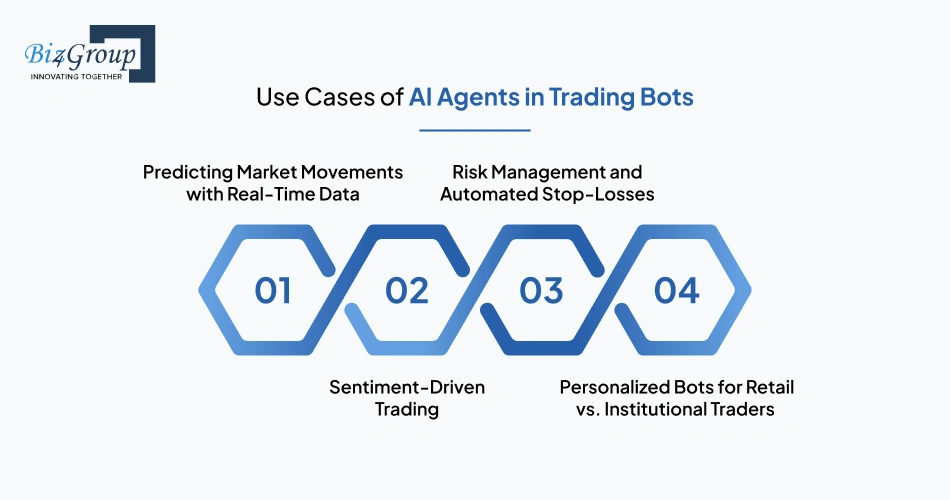
AI agents are transforming trading bots from simple automation tools into intelligent systems capable of adapting to ever-changing markets. Let’s look at some of the most impactful use cases where traders benefit from this new wave of technology.
Traditional bots often rely on static indicators like moving averages or RSI. AI-powered bots, however, can process real-time data streams across multiple exchanges, detect hidden patterns, and anticipate price movements with higher accuracy. For example, an AI agent can recognize subtle shifts in order book depth before a breakout occurs — something human traders would likely miss.
Markets don’t move on charts alone — they move on news and sentiment. AI agents equipped with Natural Language Processing (NLP) can scan financial news, social media platforms like Twitter or Reddit, and even central bank speeches to detect mood shifts. A sudden wave of negative sentiment could trigger a bot to exit a position before the market reacts, giving traders a crucial edge.
Risk is where many traders stumble, but AI agents excel at dynamic risk management. Instead of using fixed stop-losses, an AI-driven bot can adjust exit points based on volatility, liquidity, or breaking news events. For instance, during a flash crash, the bot could instantly scale down exposure or hedge positions — protecting the trader from catastrophic losses.
AI agents also allow for personalization at scale.
These examples highlight how trading bots building with AI agents can adapt to complex trading environments. By combining speed, intelligence, and flexibility, AI-driven bots aren’t just assistants — they’re becoming strategic partners for traders of all levels.
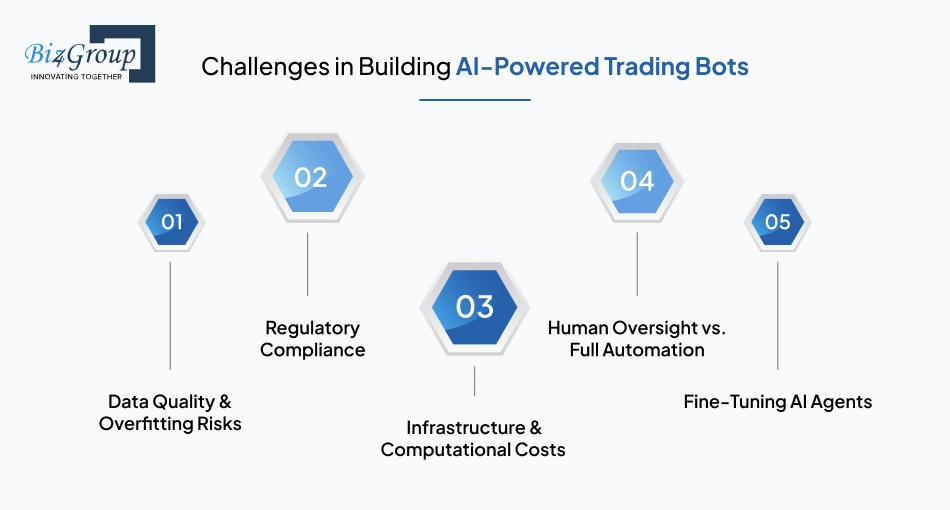
While AI agents unlock new opportunities in trading, building and managing these bots is not without challenges. Traders and institutions face several obstacles before seeing consistent success.
AI models are only as good as the data they train on. Poor-quality or biased datasets can lead to overfitting — where a model performs well in backtests but fails in real-world markets. Ensuring data integrity, diversity, and proper preprocessing is critical.
How Biz4Group Helps: They design data pipelines and cleansing mechanisms to ensure trading bots are fed with accurate, real-time data. Their expertise in AI model training reduces overfitting risks and improves model robustness.
Financial trading is heavily regulated. From KYC/AML compliance to market regulations, building a trading bot requires adherence to strict legal frameworks. A bot that isn’t compliant risks penalties or bans.
How Biz4Group Helps: They integrate compliance checks and audit-ready features into trading platforms, ensuring bots meet industry standards while staying future-ready for evolving regulations.
High-performance AI trading bots often require GPU clusters, cloud servers, and scalable databases, which can be costly. Without the right infrastructure, performance bottlenecks can limit profitability.
How Biz4Group Helps: As a leading cloud and AI development company, Biz4Group sets up scalable cloud infrastructure on platforms like AWS and Azure. They optimize costs while ensuring bots can handle real-time data at scale.
While automation is powerful, leaving a bot completely unsupervised can be risky. Market anomalies, flash crashes, or sudden news events can trigger unexpected outcomes. Traders must balance automation with human oversight.
How Biz4Group Helps: They provide custom dashboards and chatbot integrations so traders can monitor, interact with, and override bot decisions when necessary — striking the right balance between automation and control.
Every market behaves differently. A strategy that works in crypto may fail in forex. Bots require continuous fine-tuning to adapt to asset classes, volatility regimes, and user preferences.
How Biz4Group Helps: Their team specializes in AI agent fine-tuning services, ensuring bots continuously learn and adjust. They support ongoing optimization to keep strategies profitable and aligned with traders’ goals.
Even though many traders aim to develop trading bot with AI agent, they must balance innovation with caution. With the right partner, like Biz4Group, traders can overcome these challenges and build bots that are reliable, compliant, and adaptive.
Turn strategy into science with AI-driven trading.
Develop Your AI Bot Now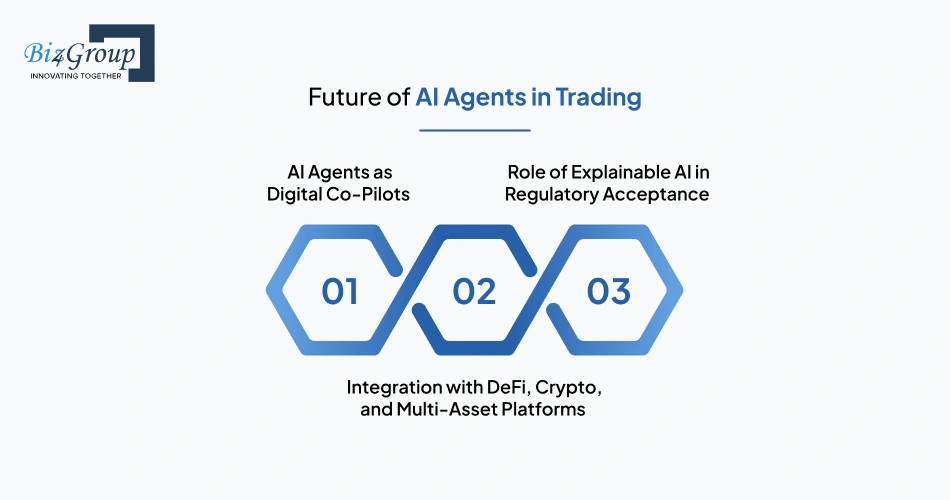
The journey of AI in trading is only beginning. As financial markets evolve, AI agents are expected to become digital co-pilots for traders, offering not just automation but real-time guidance and decision support. Instead of replacing traders, these systems will augment human judgment by providing data-driven insights, personalized recommendations, and predictive alerts before critical market moves.
In the near future, AI trading bots will function much like copilots in aviation — constantly scanning the environment, highlighting risks, and suggesting optimal maneuvers. A trader might receive an AI alert: “Liquidity is drying up on this exchange; consider adjusting your position.” This level of intelligent assistance could become standard for both retail and institutional traders.
As digital assets continue to grow, AI agents will expand beyond traditional stocks trading and forex into crypto, decentralized finance (DeFi), and tokenized assets. Imagine a single AI-powered bot seamlessly trading across multiple asset classes equities, futures, crypto trading, and even NFTs — while optimizing for liquidity and minimizing risk. Such multi-asset integration could reshape portfolio management, enabling diversification with minimal manual effort.
One of the barriers to widespread adoption is regulation. Regulators often hesitate to approve black-box AI systems that make decisions without transparency. This is where explainable AI (XAI) will play a crucial role. Future trading bots will not only execute trades but also justify their decisions in human-readable form: “This position was taken because sentiment was positive, volatility was low, and the trend confirmed by moving averages.” Such transparency will improve trust, encourage adoption, and make compliance easier.
AI agents are reshaping the world of trading, turning traditional bots into intelligent, adaptive systems that can analyze data, respond to market volatility, and even interact with traders through conversational interfaces. From predicting price movements and managing risk to integrating across asset classes, the benefits of using AI agents in trading bots are clear: speed, intelligence, flexibility, and continuous learning.
For traders, the key is balance. While AI can provide powerful tools, markets are unpredictable, and no system is foolproof. That’s why it’s important to experiment in controlled environments, test strategies thoroughly, and gradually build confidence before scaling.
If you’re looking to develop trading bot using AI agent, start small, backtest rigorously, and keep learning. With the right approach — and possibly the right development partners — AI-powered trading bots can become not just tools, but reliable co-pilots in your trading journey.
There are several types of AI-powered trading bots designed for different markets and strategies:
These categories highlight how diverse the AI trading ecosystem has become, giving traders options depending on their goals, risk tolerance, and preferred asset classes.
AI agents bring adaptability, learning, and decision-making capabilities that traditional rule-based bots lack. While traditional bots follow static instructions, AI agents can analyze real-time data, adjust strategies dynamically, and learn from past performance — making trading bots smarter and more effective in volatile markets.
The cost varies depending on complexity, infrastructure, and data requirements. A DIY trader might spend $2,000–$10,000, while professional traders or startups may invest $25,000–$100,000. Enterprise-grade bots with premium data feeds, cloud servers, and chatbot integration can cost $100,000–$500,000+. The overall cost of developing a trading bot using AI agents depends on scale, features, and fine-tuning needs.
Yes, traders without coding skills can still access AI-powered bots through pre-built platforms or by working with a Python development company or AI agent development company. Many platforms now offer user-friendly interfaces, while custom development partners can create tailored bots to match specific trading strategies.
Despite their advantages, AI trading bots are not foolproof. Risks include poor data quality, overfitting in training models, regulatory challenges, and infrastructure costs. Human oversight remains essential, as no AI system can guarantee profits in unpredictable markets. Regular monitoring and fine-tuning help minimize these risks.
with Biz4Group today!
Our website require some cookies to function properly. Read our privacy policy to know more.